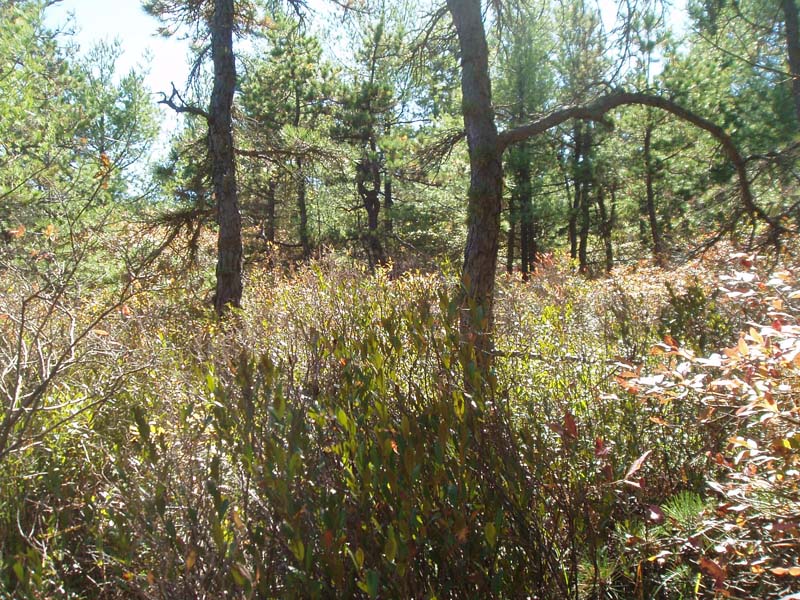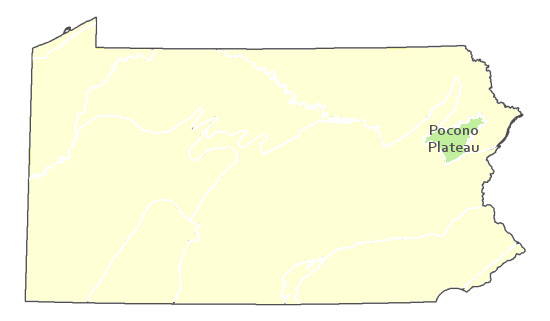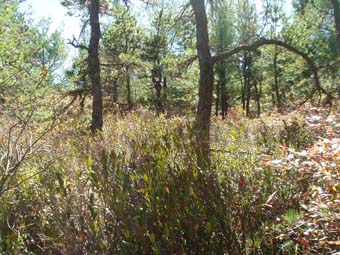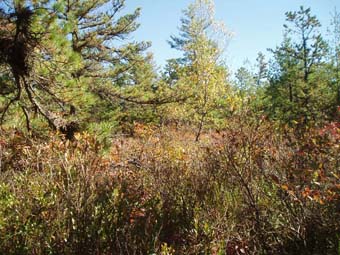Pitch Pine – Leatherleaf Palustrine Woodland
System: Palustrine
Subsystem: Woodland
PA Ecological Group(s): Basin Wetland
Global Rank:GNR
![]() rank interpretation
rank interpretation
State Rank: S2

General Description
These wetlands occur on shallow peat over glacial till, often in burned-over areas, and/or in small, relatively closed basins. Scattered gray birch (Betula populifolia), eastern white pine (Pinus strobus), and red maple (Acer rubrum) may also occur, although pitch pine (Pinus rigida) is usually the dominant tree. Leatherleaf (Chamaedaphne calyculata) generally forms a dense, low shrub layer. Other shrubs include black chokeberry (Photinia melanocarpa), velvetleaf blueberry (Vaccinium myrtilloides), sheep laurel (Kalmia angustifolia), Labrador-tea (Rhododendron groenlandicum), rhodora (Rhododendron canadense), black huckleberry (Gaylussacia baccata), and scattered highbush blueberry (Vaccinium corymbosum). There is a dense sphagnum layer beneath, often with cranberry (Vaccinium macrocarpon). Common herbaceous species include the sedge, (Carex trisperma), and cotton-grass (Eriophorum vaginatum). This community may grade into the pitch pine-rhodora-scrub oak barrens community, a community that is similar structurally and may contain many of the same species but is an upland type.
Rank Justification
Imperiled because of rarity due to very restricted range, very few populations (often 20 or fewer), steep declines, or other factors making it very vulnerable to extirpation.
Identification
- Dominated by pitch pine (Pinus rigida) and leatherleaf (Chamaedaphne calyculata)
- Typically associated with scrub oak and pitch pine barrens on ridgetops
- Canopy cover is between 10% and 60%
Shrubs
Herbs
Bryophytes
* limited to sites with higher soil calcium
Vascular plant nomenclature follows Rhoads and Block (2007). Bryophyte nomenclature follows Crum and Anderson (1981).
International Vegetation Classification Associations:
USNVC Crosswalk:None
Representative Community Types:
Pitch Pine Bog (CEGL006194)
NatureServe Ecological Systems:
North-Central Interior and Appalachian Acidic Peatland (CES202.606)
NatureServe Group Level:
None
Origin of Concept
Pennsylvania Community Code*
WP : Pitch pine – Leatherleaf Palustrine Woodland
*(DCNR 1999, Stone 2006)
Similar Ecological Communities
The dominance of pitch pine (Pinus rigida) along with leatherleaf (Chamaedaphne calyculata) distinguish Pitch Pine – Leatherleaf Palustrine Woodland from the other leatherleaf dominated community types such as Leatherleaf – Bog-rosemary Bog, Leatherleaf – Cranberry Bog, and Leatherleaf – Sedge Wetland.
Fike Crosswalk
Pitch Pine - Leatherleaf Palustrine Woodland
Conservation Value
This community is often found as part of the Ridgetop Acidic Barrens complex, which is a rare ecosystem in Pennsylvania supporting rare species. Rare plant species found in this community may include Labrador-tea (Rhododendron groenlandicum) and thread rush (Juncus filiformis). Pitch Pine – Leatherleaf Palustrine Woodlands may serve as habitat for birds of open low scrub habitats, such as white-throated sparrows (Zonotrichia albicollis).
Threats
Development and fire suppression are probably the greatest threats since the type appears to need fire to maintain its species composition and open canopy. Clearing and development of adjacent land can lead to an accumulation of run-off, pollution, and sedimentation.
Management
Development should be restricted to prevent encroachment. This community is found in fire-maintained landscapes and controlled fires need to be allowed to sweep through the system on occasion. This community is probably not connected to the regional aquifer as it is perched above it for most of the year and is subject to drought. It depends on precipitation and run-off from surrounding uplands for surface water input. Where disturbances are unavoidable, the wetland should be monitored for changes in vegetation, especially invasive species.
Research Needs
The role of fire in this community type needs to be investigated. Further, the role of factors such as frost, drought, heat, and inundation frequency and duration are not known. Variations may occur at ecoregional levels. There is a need to collect collect plot data to characterize variations of this community to assist further classification and determine if there are changes with time and lack of disturbance.
Trends
Pitch Pine – Leatherleaf Palustrine Woodland is probably relatively stable since the environmental conditions where this type is found are generally inhospitable to most invasive plants: soils that are low in nutrients, frequent fire, drought, water-logging, and frost. Without fire and other disturbances, this type may gradually succeed into a forested wetland.
Range Map

Pennsylvania Range
Pocono Plateau
Global Distribution
Connecticut, Maine, Massachuestts, New Hampshire, New Jersey, New York, Pennsylvania, Rhode Island, Vermont, as well as Quebec, Canada
Cowardin, L.M., V. Carter, F.C. Golet, and E.T. La Roe. 1979. Classification of wetlands and deepwater habitats of the United States. U.S. Fish and Wildlife Service. Washington, D.C. 131 pp.
Edinger, Gregory J., D.J. Evans, Shane Gebauer, Timothy G. Howard, David M. Hunt, and Adele M. Olivero. 2002. Ecological Communities of New York State. Second Edition. A revised and expanded edition of Carol Reschke's Ecological Communities of New York State. New York Natural Heritage Program, New York State Department of Environmental Conservation. Albany, NY. 136 pp.
Fike, J. 1999. Terrestrial and palustrine plant communities of Pennsylvania. Pennsylvania Natural Diversity Inventory. Harrisburg, PA. 79 pp.
Larsen, J.A. 1982. Ecology of Northern Lowland Bogs and Conifer Forests. Academic Press, New York.
NatureServe. 2009. NatureServe Central Databases. Arlington, Virginia. USA
Pennsylvania Department of Conservation and Natural Resources (DCNR). 1999. Inventory Manual of Procedure. For the Fourth State Forest Management Plan. Pennsylvania Bureau of Forestry, Division of Forest Advisory Service. Harrisburg, PA. 51 ppg.
Rhoads, A.F. and T.A. Block. 2007. The Plants of Pennsylvania, 2nd ed. University of Pennsylvania Press.
Stone, B., D. Gustafson, and B. Jones. 2006 (revised). Manual of Procedure for State Game Land Cover Typing. Commonwealth of Pennsylvania Game Commission, Bureau of Wildlife Habitat Management, Forest Inventory and Analysis Section, Forestry Division. Harrisburg, PA. 79 ppg.
Thompson, E. 1996. Natural communities of Vermont uplands and wetland. Nongame and Natural Heritage Program, Department of Fish and Wildlife in cooperation with The Nature Conservancy, Vermont chapter.
Wenger, S. 1999. A Review of the Scientific Literature on Riparian Buffer Width, Extent and Vegetation. Office of Public Outreach, Institute of Ecology, Univ. of Georgia, Athens.
Cite as:
Davis T. 2022. Pennsylvania Natural Heritage Program. Pitch Pine – Leatherleaf Palustrine Woodland Factsheet. Available from: https://www.naturalheritage.state.pa.us/Community.aspx?=16051 Date Accessed: April 26, 2024








